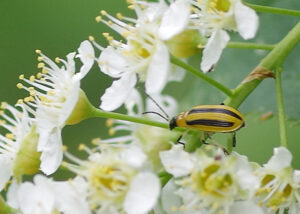Note: All links except the first one go to external sites.
Howdy, BugFans,
The BugLady is not a gardener (she does get pretty excited about the Seed Savers catalog, though, put out by folks who are dedicated to preserving heritage species). So, perhaps she looked at this pretty little leaf beetle with different eyes than someone would who was trying to grow squash. It’s not in the same genus as the related Spotted cucumber beetle (Diabrotica undecimpunctata) that appeared in BOTW in 2011, but its lifestyle is somewhat similar.
The Striped cucumber beetle (Acalymma vittatum) (vittatum means “banded” or “striped”) is on Wanted Posters of a whole slew of North American agricultural agencies east of the Rockies (it’s replaced in the Far West by Acalymma trivittatum). In fact, the Striped cucumber beetle is so notorious that the bugguide.net entry didn’t even pop up until page 5 of the internet hits. It’s in the huge leaf beetle family Chrysomelidae (one of the largest beetle families – 35,000-ish species total, 1,900 of them in North America). With 390,000 species worldwide, Coleoptera (the beetle order) is the largest single order in the entire animal kingdom.
It’s not a huge beetle, maybe ¼ inch long, with a black (sometimes brown) head, a black undercarriage, an orangey thorax, and black and yellow striped elytra (hard wing covers) covering the membranous wings that are used for flying.
There can be several generations per year, depending on your latitude. The final generation of unmated adult StCBs overwinters in leaf litter or just under the soil surface, and when spring comes, a young beetle’s fancy turns first, to food, and then to love. Newly awakened adults feed on pollen, petals, and leaves of willow, aspen, hawthorn (they especially like members of the Rose family), and other plants around the edges of fields while they’re waiting for farmers and gardeners to deliver the squash plants.
When the squash seedlings are waving their tender cotyledons in the air, the beetles climb on board (en masse – more about that in a sec) and mate. They can feed on alternate plants, but they only mate and oviposit on members of the squash family. Females lay small clusters of bright orange eggs (up to 1,500 during her lifetime) in cracks in the dirt on or near the stem of the host plant, and newly-hatched larvae dig down and feed on the roots before pupating in the soil.
Which brings us to those Wanted Posters. Both the adults and the larvae love all things squash, from butternuts and cucumbers to pattypans and watermelons. Larvae feed low, on the roots and stems of the squash plant, and adults eat flowers and leaves (and may defoliate a plant), but they especially enjoy feeding on the underside of the fruits.
Seedlings can be killed outright by their grazing; chewing on flowers makes pollination difficult; fruit scarred by the adults is less marketable; and sometimes the fruit develops rot after being punctured. The one-two punch occurs when a beetle transmits to the plant a virus called squash mosaic virus, a fungus that causes black rot, and/or a bacteria that causes wilt. The bacteria can survive the winter in a beetle’s gut, and plants become infected when frass (bug poop) lands on an open spot on the plant stem where the beetle has been nibbling. The bacteria multiply and eventually block the plant’s xylem tissue (plumbing). Larval feeding on root tissue hinders root development and can spread a Fusarium fungus.
Squashes protect themselves from herbivores by manufacturing bitter protective chemicals called cucurbitacins. While these chemicals effectively repel (and even kill) many grazers, they don’t hinder the beetle for a second – in fact, they actually make the plants even more desirable to StCBs and other squash-specialists. StCBs that are feeding on squashes produce an aggregation pheromone that calls more StCBs to the table, and to add insult to injury, researchers suspect that the cucurbitacins may be sequestered by the beetles in their elytra in order to deter predators.
This attraction to a deterrent chemical that acts like a feeding stimulant for StCBs is cited as an example of co-evolution. It’s also (and the BugLady is getting into some deep water here, chemically) an example of kairomones or kairomonal feeding. Mark Klowden, in Physiological Systems in Insects, explains it this way, “Kairomones (Greek: kairos, opportunistic) benefit the receiver rather than the emitter. They have been described as pheromones and allomones that have evolutionarily backfired……. Kairomones may be hormones, pheromones, or allomones that are normally used by one organism but exploited by an illegitimate receiver. They may be normal products of metabolism of one species that are now used by another to locate its host.” Producing cucurbitacins is supposed to benefit squash by discouraging the beetles, but, for their trouble, the squash end up attracting the beetles instead, at the plant’s expense (so, the question is – do squash plants get another benefit from producing cucurbitacins?).
Happy gardening, and be sure to plant some extra dill for the Black Swallowtail caterpillars.
–The BugLady
